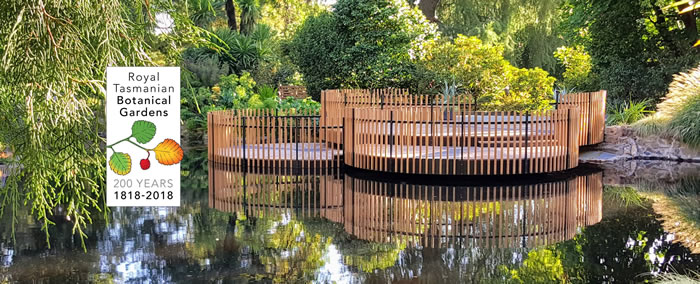Royal Tasmanian Botanical Gardens |

The Royal Tasmanian Botanical Gardens, which cover an area of approximately 14 hectares, in Hobart located within the Queens Domain.
The Royal Tasmanian Botanical Gardens hold historic plant collections and a large number of significant trees, many dating from the nineteenth century.
Features at a glance:
In addition to its beautiful parklands and collection of large trees, the Royal Tasmanian Botanical Gardens is home to an ever-evolving and significant number of specialised collections and gardens.
Especially unique are the extensive Tasmanian native collections, which provide real live plant examples that can be used by visitors to help them identify plants they have encountered in the wild, it includes many rare and threatened species.
Some parts of the Gardens have special significance for people who have made them a feature of their celebrations and festivities over the many years.
Many areas of the Gardens are available for hire for private functions. For information on hiring, view the Venue Hire page.
The Conservatory
The massed colour and scent from our ever-changing Conservatory display make this a 'must-see' experience while you're visiting the Gardens.
Wander through the Conservatory to admire the plants, or rest a while on the seats near the sandstone fountain.
The Conservatory was designed by Superintendent Ira Thornicroft, and completed in 1939. Its walls are built of sandstone salvaged from a demolished section of the Hobart General Hospital.
Historic Walls
In 1829, Governor George Arthur ordered the construction of a heated wall to protect frost tender plants and extend growing periods of fruit trees on the boundary of the Colonial Gardens.
In the milder climate of Van Diemen's Land, fruit trees flourished without artificial heat, and the convict-built wall was only heated for a few years.
Perhaps to rival Arthur's wall, Governor Sir John Eardley-Wilmot also ordered the construction, also by convicts, of a wall 280 metres long on the eastern boundary of the Gardens.
The walls provide structure and unique heritage value to the Gardens.
More information: Arthur Wall, Eardley-Wilmot Wall
Anniversary Arch
Just a short distance from the Botanical Gardens Restaurant and Visitor Centre, this romantic carved arch is set at the base of stone steps surrounded by tall shady trees and shrubs. It is a popular site for weddings and ceremonies.
The arch was originally constructed in 1913 to span the entrance of the Australian Mutual Provident Society's original Elizabeth Street building. When that building was demolished, AMP donated the arch to the Gardens. It was re-erected in 1968 in time for celebrations of the Gardens' 150th Anniversary.
The intricately carved stonework shows the skilled craftsmanship of Mr Amos Vimpany, a well known local stonemason of the time.
Lily Pond
One of the most recognisable and beloved areas of the Gardens, the Pond was formed in 1840 by damming a natural stream that drained the adjacent hill. Originally used as a reservoir, water lilies have grown in the pond for more than 100 years.
The nymphae lilies are planted in pots on the bottom of the pond. Dormant over winter, they shoot in spring and flower throughout summer. There are over twenty different cultivars present, flowering in shades of white, apricot, pink, red and yellow.
The Lily Pond, with its picturesque setting and bridge, is a popular spot for photographs and weddings.
Fuchsia House
The Fuchsia House originally dates from 1958 and was redesigned in 1995. It now displays more than 190 varieties of one of the most adaptable and varied exotic ornamentals.
Fuchsias were first discovered in the Caribbean Islands, the first being named in honour of Dr Fuchs, a sixteenth century botanist and doctor. They are now known to range from Mexico to Patagonia, and are also found in Tahiti and New Zealand.
The Fuchsia House can be seen at its best from late October through until March.
Wombat One
The "Wombat One"shelter at the north Western end of the Botanic Gardens was originally developed as a project by the staff and students from the School of Environmental Design at the Tasmania College of Advanced Education, in the late 1970's. The project was essentially a prototype model and showcase for the demonstration of a unique timber construction system using commonsense and environmentally sound practices with the use of timber in construction. The project aimed to foster a more respectful attitude towards the use of timbers from native forests.
The Burrow
Officially launched on the 3rd of October 2012 by The Honourable Peter Underwood AC, Governor of Tasmania, The Burrow is a free community resource providing people with the opportunity to escape for a while from the rigours of everyday life.
Set in the magnificent surroundings of the Botanical Gardens the Burrow is a special space full of donated books and records for people to read and enjoy. The Burrow also includes a large TV screen continually showcasing some of Tasmania's best short films.
While The Burrow has been set up for Able Tasmania's clients, the Able model of community access ensures that all their projects are built for the community as a whole.
The Burrow while disability friendly, is not a disabled facility, it is a community room, that all can use, friendships can be made, and Able clients can share.
The project has also benefited from generous sponsorship, and thanks and public recognition are due to: Hydro Tasmania; the Braille Writers Association; Bunnings Warehouse; St Vincent De Paul; and Wide Angle Tasmania.
Other significant Gardens features include:
Visitors Centre
Subantarctic Plant House
Tasmanian Community Food Garden
French Explorers Collection
Tasmanian Fern House
Seed Bank
Where are we?
The Royal Tasmanian Botanical Gardens are on the Queens Domain, about two kilometres (1.2 miles) from the centre of Hobart.
Walk
The Gardens are a pleasant walk of about 25 minutes in a northerly direction from the city. There are pedestrian crossings at the city end of the Tasman Highway, and a highway underpass at the Cenotaph. Use the link "Getting there..."above for more details on the Hobart walk. If you walk or bike just remember that at certain times of the year Hobart can get cooler breezes, which on hot summer days can be wonderful, but at other times make sure you wear clothing layers so that you can easily adjust to your desired temperature.
Bike
Cycling tracks run from city, along both sides of the Tasman Highway towards the Tasman Bridge. A highway underpass at the Cenotaph provides access towards our main gates, while a cycling track along the Derwent River foreshore passes an entrance gate off the lower car parking area. Take care when crossing the Lower Domain Highway.
Drive
Parking is available at both entrances to the Gardens, at Lower Domain Road for the main entrance and the Domain Highway for the lower entrance.
Bus
While regular bus services do not operate to the Gardens, various private bus and tour services include the Gardens on their tour around Hobart. Space is provided at our main entrance for private coaches and buses to load and unload. Red Decker buses have services to the Gardens.
❊ Address ❊
⊜ Lower Domain Road, Queens Domain, Hobart View Map
℅ nipaluna
✆ Telephone: 03 6166 0451
❊ What's On ❊
Coming to Royal Tasmanian Botanical Gardens..➼ Royal Tasmanian Botanical Gardens | Open
❊ More Information ❊
→
gardens.rtbg.tas.gov.au
➼ www.gardens.rtbg.tas.gov.au
Update Page








